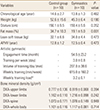1. Silva DR, Werneck AO, Collings PJ, et al. Physical activity maintenance and metabolic risk in adolescents. J Public Health (Oxf). 2018; 40:493–500.

2. Stamatakis E, Coombs N, Tiling K, et al. Sedentary time in late childhood and cardiometabolic risk in adolescence. Pediatrics. 2015; 135:e1432–e1441.

3. Wright NC, Looker AC, Saag KG, et al. The recent prevalence of osteoporosis and low bone mass in the United States based on bone mineral density at the femoral neck or lumbar spine. J Bone Miner Res. 2014; 29:2520–2526.

4. Kanis JA. Diagnosis of osteoporosis and assessment of fracture risk. Lancet. 2002; 359:1929–1936.

5. Bielemann RM, Domingues MR, Horta BL, et al. Physical activity throughout adolescence and bone mineral density in early adulthood: the 1993 Pelotas (Brazil) Birth Cohort Study. Osteoporos Int. 2014; 25:2007–2015.

6. Boreham CA, McKay HA. Physical activity in childhood and bone health. Br J Sports Med. 2011; 45:877–879.

7. Maillane-Vanegas S, Agostinete RR, Lynch KR, et al. Bone mineral density and sports participation. J Clin Densitom. 2018; DOI:
10.1016/j.jocd.2018.05.041.

8. Ubago-Guisado E, Gómez-Cabello A, Sánchez-Sánchez J, et al. Influence of different sports on bone mass in growing girls. J Sports Sci. 2015; 33:1710–1718.

9. Lynch KR, Kemper HCG, Turi-Lynch B, et al. Impact sports and bone fractures among adolescents. J Sports Sci. 2017; 35:2421–2426.

10. Vlachopoulos D, Barker AR, Ubago-Guisado E, et al. The effect of 12-month participation in osteogenic and non-osteogenic sports on bone development in adolescent male athletes. The PRO-BONE study. J Sci Med Sport. 2018; 21:404–409.

11. Madsen KL, Adams WC, Van Loan MD. Effects of physical activity, body weight and composition, and muscular strength on bone density in young women. Med Sci Sports Exerc. 1998; 30:114–120.

12. Faustino-da-Silva Y, Agostinete RR, Werneck AO, et al. Track and field practice and bone outcomes among adolescents: a pilot study (ABCD-Growth Study). J Bone Metab. 2018; 25:35–42.

13. Proctor KL, Adams WC, Shaffrath JD, et al. Upper-limb bone mineral density of female collegiate gymnasts versus controls. Med Sci Sports Exerc. 2002; 34:1830–1835.

14. Fehling PC, Alekel L, Clasey J, et al. A comparison of bone mineral densities among female athletes in impact loading and active loading sports. Bone. 1995; 17:205–210.

15. da Silva CC, Teixeira AS, Goldberg TBL. Sport and its implications on the bone health of adolescent athletes. Rev Bras Med Esporte. 2003; 9:433–438.
16. Nichols DL, Sanborn CF, Bonnick SL, et al. The effects of gymnastics training on bone mineral density. Med Sci Sports Exerc. 1994; 26:1220–1225.

17. Dowthwaite JN, Rosenbaum PF, Scerpella TA. Mechanical loading during growth is associated with plane-specific differences in vertebral geometry: a cross-sectional analysis comparing artistic gymnasts vs. non-gymnasts. Bone. 2011; 49:1046–1054.

18. Erlandson MC, Kontulainen SA, Chilibeck PD, et al. Former premenarcheal gymnasts exhibit site-specific skeletal benefits in adulthood after long-term retirement. J Bone Miner Res. 2012; 27:2298–2305.

19. Malina RM, Bouchard C, Bar-Or O. Growth, maturation, and physical activity. 2nd ed. Champaign, IL: Human kinetics;2004.
20. Jackowski SA, Erlandson MC, Mirwald RL, et al. Effect of maturational timing on bone mineral content accrual from childhood to adulthood: evidence from 15 years of longitudinal data. Bone. 2011; 48:1178–1185.

21. Vicente-Rodriguez G, Dorado C, Ara I, et al. Artistic versus rhythmic gymnastics: effects on bone and muscle mass in young girls. Int J Sports Med. 2007; 28:386–393.

22. McGuigan MR, Al Dayel A, Tod D, et al. Use of session rating of perceived exertion for monitoring resistance exercise in children who are overweight or obese. Pediatr Exerc Sci. 2008; 20:333–341.

23. Foster C, Florhaug JA, Franklin J, et al. A new approach to monitoring exercise training. J Strength Cond Res. 2001; 15:109–115.

24. Werneck AO, Agostinete RR, Cayres SU, et al. Association between cluster of lifestyle behaviors and HOMA-IR among adolescents: ABCD growth study. Medicina (Kaunas). 2018; 54.

25. Moore SA, McKay HA, Macdonald H, et al. Enhancing a somatic maturity prediction model. Med Sci Sports Exerc. 2015; 47:1755–1764.

26. Mirwald RL, Baxter-Jones AD, Bailey DA, et al. An assessment of maturity from anthropometric measurements. Med Sci Sports Exerc. 2002; 34:689–694.

27. Malina RM, Baxter-Jones AD, Armstrong N, et al. Role of intensive training in the growth and maturation of artistic gymnasts. Sports Med. 2013; 43:783–802.

28. Tsukamoto MHC, Nunomura M. Maturational features in female olimpic gymnasts. Motriz. 2003; 9:119–126.
29. Alves C, Lima RVB. Linear growth and puberty in children and adolescents: effects of physical activity and sports. Rev Paul Pediatr. 2008; 26:383–391.
30. Burt LA, Greene DA, Naughton GA. Bone health of young male gymnasts: A systematic review. Pediatr Exerc Sci. 2017; 29:456–464.

32. Tenforde AS, Fredericson M. Influence of sports participation on bone health in the young athlete: a review of the literature. PM R. 2011; 3:861–867.

33. Yang PF, Brüggemann GP, Rittweger J. What do we currently know from in vivo bone strain measurements in humans? J Musculoskelet Neuronal Interact. 2011; 11:8–20.
34. Haering D, Huchez A, Barbier F, et al. Identification of the contribution of contact and aerial biomechanical parameters in acrobatic performance. PLoS One. 2017; 12:e0172083.

35. Jaffré C, Courteix D, Dine G, et al. Physical exercise and bone turnover: a study in young girl gymnasts. Sci Sports. 2001; 16:321–322.
36. Zanatta LC, Boguszewski CL, Borba VZ, et al. Osteocalcin, energy and glucose metabolism. Arq Bras Endocrinol Metabol. 2014; 58:444–451.

37. Zanatta LCB, Boguszewski CL, Borba VZC, et al. Association between undercarboxylated osteocalcin, bone mineral density, and metabolic parameters in postmenopausal women. Arch Endocrinol Metab. 2018; 62:446–451.









 PDF
PDF ePub
ePub Citation
Citation Print
Print




 XML Download
XML Download